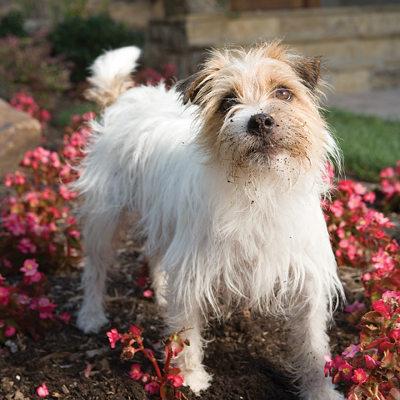
September 4, 2013
PetSafe® Expert
PetSafe® Guest
"Little Dog" Syndrome - Reducing Big Dog Anxiety in Smaller Dogs
By Toni Gibson-Mark, KPA-CTP
Small dogs can be some of the most amazing dogs! However, sometimes people associate little dogs with certain undesirable behaviors, such as yappy barking, ankle biting, cowering when people approach, or increased aggression when approaching their space. It’s important to consider why these behaviors are happening so they can properly be addressed.

The world can be a big scary place for small dogs!
It isn’t okay for any dog to be biting or engage in other aggressive behaviors, no matter what size they are. Similarly, we want every dog to be comfortable in their environment so that they don’t feel fearful. But the reality of the situation is that we live in a big, big world that can be really scary for little dogs. Take a look at what a small dog has to go through. If you’re able to, lay down on the ground and place your head around the same height that your small dog’s would be. The world gets a lot bigger, right? Now, have people walk by and stand over you. It can be intimidating! That type of intimidating environment can be very scary for a small dog.
Sometimes when a dog is scared, they’ll show fearful body language, such as cowering, pinned back ears, or lying flat on the floor. Other times, that fear can turn defensive, and a dog can exhibit aggressive behaviors, such as growling, barking, snapping, or biting. The easiest way to eliminate these behaviors is to make sure that the dog doesn’t get to that level of fear or anxiety. Remember, the responsibility of protecting your dog lies with you. Here are a few things that you can do to help create a comfortable environment for your small dog so that he doesn’t feel fearful or aggressive.
- First, keep in mind that your small dog is—well—small! When he’s in big, crowded places, this can be very scary. The fear of being stepped on is very intimidating. In instances that are chaotic, consider picking up your dog so that they feel safer and more secure in your arms. When you are about to interact with a small dog, you should try to make yourself smaller. People can be very big to small dogs, so if you’re able to, bend down to the dog’s level. Extend a hand out so that the dog can sniff you before engaging. When the dog feels comfortable, you can pet the dog. When you want to pick up a small dog, make sure the dog is comfortable first. Bending over and picking up the dog without any notice can be scary. First, get down to the dog’s level and let the dog sniff you. When the dog is comfortable, pet him first. Then, if he continues to be comfortable, you can place your hands on him and slowly lift him off the ground. Going at the dog’s pace will mean that the dog will be comfortable being off the ground in your arms.

- Make sure that small dogs are comfortable and safe around big dogs. Be considerate of your dog when he is interacting with bigger dogs. Some big dogs might just want to play, but that play behavior can still be intimidating or dangerous to a small dog. If a big dog pounces playfully onto a small dog, it can potentially cause an injury to a small dog. More aggressive play behavior in big dogs can be potentially life-threatening for small dogs.
- If your dog can be territorial over certain places, such as the couch, teach your dog an “On” and “Off” cue for that space. When you can cue your dog to get off of the space where they might become territorial, this prevents potential aggressive behavior towards you. However, if you do cue your dog to get off the space, be sure that they have another space that they can comfortably get to and hang out in, which is free from other people. It’s great to have a dog bed or similar place for a small dog to go to where they can feel safe and won’t be bothered by people.

- Even though barking can be frustrating for owners, it’s something to carefully pay attention to. While some small dogs might just bark for fun, other times there might be a reason why they’re barking. Are they scared? Is someone imposing on their space? Is their environment intimidating in some way? If so, go rescue your dog! Take them to a place where they’ll be more comfortable.
- Engage in positive reinforcement training. When you train your small dog to perform even the most basic tricks, like “sit” or “lay down” using positive reinforcement, it not only trains them to be good dogs, but it also develops a deep and encouraging relationship between the two of you. If you and your dog have a history of happy transactions (you ask dog for behavior and you pay him for it when he does it), your dog will trust you. This can significantly reduce their anxiety when they are in an intimidating situation and you are there to rescue them.
Most of all, it’s so important to be considerate of our small dogs. Even though their cowering might not be as big and their barks as loud, it’s still absolutely imperative to consider their environment. In order for a small dog to productively exist in their world, they need to feel comfortable. The only way to ensure that their environment is comfortable is to hire their number one advocate to do the job—and that’s you!
Having a great relationship with a happy small dog can be a lot of fun!
Get Email Updates
Subscribe to the latest news, promotions, & more from PetSafe® brand.
Sign up today for the latest news, promotions, and more from PetSafe® brand.



